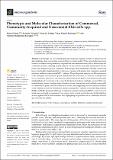Files in this item
Phenotypic and molecular characterization of commensal, community-acquired and nosocomial Klebsiella spp.
Item metadata
| dc.contributor.author | Gómez, Marta | |
| dc.contributor.author | Valverde, Arancha | |
| dc.contributor.author | del Campo, Rosa | |
| dc.contributor.author | Rodríguez, Juan Miguel | |
| dc.contributor.author | Maldonado-Barragán, Antonio | |
| dc.date.accessioned | 2021-11-17T12:30:10Z | |
| dc.date.available | 2021-11-17T12:30:10Z | |
| dc.date.issued | 2021-11-12 | |
| dc.identifier | 276713904 | |
| dc.identifier | ac314b9e-e2b1-4a93-baa8-52aa06ef114e | |
| dc.identifier | 85118878656 | |
| dc.identifier | 000726026000001 | |
| dc.identifier.citation | Gómez , M , Valverde , A , del Campo , R , Rodríguez , J M & Maldonado-Barragán , A 2021 , ' Phenotypic and molecular characterization of commensal, community-acquired and nosocomial Klebsiella spp. ' , Microorganisms , vol. 9 , no. 11 , e2344 . https://doi.org/10.3390/microorganisms9112344 | en |
| dc.identifier.other | Jisc: d8819da95c84446684201bf05ae5b185 | |
| dc.identifier.other | ORCID: /0000-0002-4775-346X/work/103511249 | |
| dc.identifier.uri | https://hdl.handle.net/10023/24348 | |
| dc.description | This research was funded by Ministerio de Ciencia e Innovación (Spain), grant numbers CSD2007-00063 (FUN-C-FOOD, Consolider-Ingenio 2010), AGL2010-15420 and PID2019-105606RB-I00. | en |
| dc.description.abstract | Klebsiella spp. is a relevant pathogen that can present acquired resistance to almost all available antibiotics, thus representing a serious threat for public health. While most studies have been focused on isolates causing community-acquired and nosocomial infections, little is known about the commensal isolates colonizing healthy subjects. We describe the molecular identification and the phenotypic characterization of commensal Klebsiella spp. from breast milk of healthy women and faeces from healthy breast-fed infants, which were compared with isolates from community-acquired infections and from a nosocomial NICU outbreak. The phylogenetic analysis of a 454-bp sequence of the rpoB gene was useful for species identification (K. pneumoniae, K. variicola, K. quasipneumoniae, K. oxytoca, K. grimontii, K. michiganensis, Raoultella planticola and R. ornithinolytica), previously misidentified as K. pneumoniae or K. oxytoca by biochemical methods. Globally, we report that commensal strains present virulence traits (virulence genes, siderophores and biofilms) comparable to community-acquired and NICU-infective isolates, thus suggesting that the human microbiota could constitute a reservoir for infection. Isolates causing NICU outbreak were multi-drug resistant (MDR) and ESBLs producers, although an imipenem-resistant commensal MDR K. quasipneumoniae isolate was also found. A commensal K. pneumoniae strain showed a potent bacteriocin-like inhibitory activity against MDR Klebsiella isolates, thus highlighting the potential role of commensal Klebsiella spp. in health and disease. | |
| dc.format.extent | 18 | |
| dc.format.extent | 2986618 | |
| dc.language.iso | eng | |
| dc.relation.ispartof | Microorganisms | en |
| dc.subject | Klebsiella | en |
| dc.subject | rpoB | en |
| dc.subject | Virulence | en |
| dc.subject | Siderophores | en |
| dc.subject | Biofilms | en |
| dc.subject | Antibiotic resistance | en |
| dc.subject | Bacteriocins | en |
| dc.subject | QR Microbiology | en |
| dc.subject | DAS | en |
| dc.subject | SDG 3 - Good Health and Well-being | en |
| dc.subject.lcc | QR | en |
| dc.title | Phenotypic and molecular characterization of commensal, community-acquired and nosocomial Klebsiella spp. | en |
| dc.type | Journal article | en |
| dc.contributor.institution | University of St Andrews. School of Medicine | en |
| dc.identifier.doi | https://doi.org/10.3390/microorganisms9112344 | |
| dc.description.status | Peer reviewed | en |
This item appears in the following Collection(s)
Items in the St Andrews Research Repository are protected by copyright, with all rights reserved, unless otherwise indicated.

